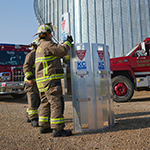Managing confined spaces
Know the hazards and how to stay safe when working in grain bins
Grain bins are just one of several types of confined spaces that require a lot of attention to safety on the farm. Some other confined spaces represent even greater hazards because of additional risks like hypoxic, toxic or explosive gases. They require extra training and attention to safety for anyone working in them.
Those types of confined spaces — known as “permit-required confined spaces” — require farmers or other workers to follow U.S. Department of Labor Occupational Safety and Health Administration (OSHA) requirements before entering them to conduct any work. Doing so is often the best way to prevent serious injury or death.
Confined spaces are defined as those large enough for someone to fully enter. But they’re also not designed for continuous occupancy and present limitations to movement, entry or exit. Permit-required confined spaces, as defined by OSHA, layer on additional hazards like:
- Hazardous atmospheres
- Engulfment potential
- Converging, sloping walls and floors that can lead to asphyxiation
- Moving parts, machinery, electrical or heating systems.
Working in a grain bin presents the hazards of potentially harmful atmospheres, engulfment and entrapment, all of which can lead to serious injury or death. As a result, grain bins are considered “permit-required” confined spaces. Others are:
- Manure pits. Toxic gases are a huge hazard for anyone working in or around a manure pit. Gases like methane, ammonia and hydrogen sulfide can create an oxygen-deficient or toxic atmosphere. Entrapment and drowning are also common manure pit hazards. Make sure you never enter a manure pit during agitation. If you must enter a pit, wear breathing equipment and a safety line, work with an observer and make sure the area is well-ventilated.
- Scale pits. These are the structures under truck scales at a grain storage facility. In addition to the hazards created by flowing grain, these pits also create potentially toxic atmospheres from carbon monoxide generated by truck exhaust. These pits should always be cleaned regularly and ventilated before anyone enters.
- Well pits. These are common structures at many farmsteads and anywhere a well is a water source. Drowning is a major hazard. Electric shock is also a hazard if electric pumps are used. Finally, oxygen-deficient or toxic air may be present, representing a suffocation hazard. To minimize these hazards, make sure all electrical equipment is maintained, entry points are covered and jobs like debris removal can be done without pit entry.
- Feed mixers. These systems feature a lot of moving parts, making entanglement and resulting dismemberment or death a major hazard. Never allow anyone near feed mixing equipment other than qualified operators. Also ensure all safety shields and guards are in place before beginning operation. Make sure all equipment is well-maintained and don’t wear loose clothing that can get caught in moving equipment.
Regardless of the confined space on your farm, make sure everyone involved — whether they’re working, observing or simply present — has the training and awareness of hazards like these. It’s also critically important to have an emergency action plan if there is an accident. They’re all parts of a plan to keep everyone safe on your farm.

 >
>

 >
>
 >
>